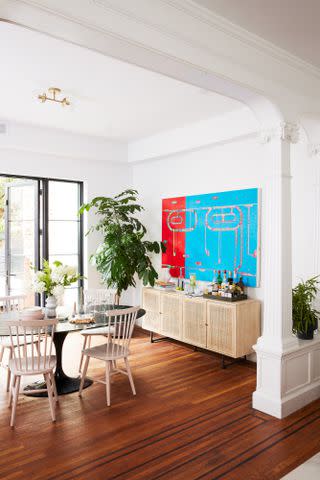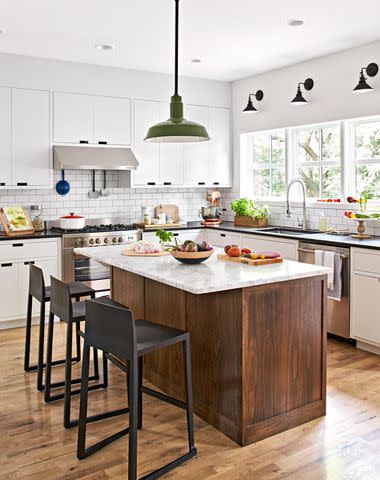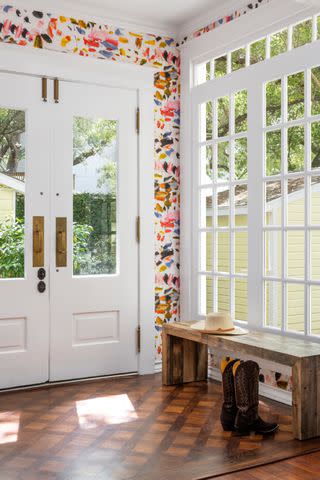4 Types of Wood Flooring and What to Consider Before Installing
Here's everything you need to know about wood floors, including types, cost, and installation.
Fact checked by Marcus Reeves
Flooring is the largest surface in any home and one of the main design elements. Picking the best type of floor will depend on your style, needs, and budget. Wood is the most popular floor material, as many homes already have it in place or underneath carpeting. It is incredibly durable, and there are many varieties, including laminate, hardwoods, engineered wood, and parquet.
However, wood floors can come with high installation and maintenance costs, depending on the type of wood. Before getting too attached to one type of wood flooring, consider the pros and cons, including installation costs, durability, and cleaning requirements.

David Land
How much does it cost to install wood flooring?
The overall cost of installing wood flooring is measured by the square foot. The tree species, thickness, grade, and grain can also determine the final cost. Generally, the price of installing wood flooring is about $5-$10 per square foot of solid wood and $4-$9 per square foot of engineered wood. Calculate a bit more for staircases and rooms with unconventional walls and curves.
Related: The 10 Best Flooring Options for Basements of 2023

Hardwood Flooring
How much does it cost to install and maintain hardwood flooring?
Hardwood flooring comes from one solid piece of wood. While it is versatile, it is also one of the most expensive types of wood flooring. It requires regular maintenance, such as specialty hardwood buffers and cleaners. Often, you’ll need to apply a fresh coat of paint or stain every three to five years.
The cost to install hardwood flooring is $5-$10 per square foot. However, uneven flooring and damaged underlayment can increase the cost. Also, the price may vary depending on the type of wood you choose and where you live. Solid hardwood is available in various options, including oak, maple, cherry, walnut, bamboo, ash, and teak. The color will depend on the species, varying from white, gray, red, and brown tones. According to Thumbtack, typical pricing per square foot varies by wood species, as outlined below.
Average Cost of Hardwood Flooring Types
Types of Wood | Cost Per Square Foot |
Pine | $3 - $6 |
Oak | $5 - $10 |
Cherry | $5 - $10 |
Brazilian Walnut | $8 - $14 |
Mahogany | $8 - $14 |
Red Oak | $11 - $14 |
White Oak | $12 - $15 |
Maple | $15 - $18 |
Pros of Hardwood Flooring
Hardwood has a natural warmth and is available in various species.
Highly resistant to wear
Can be refinished many times
Prefinished floors are very durable
Often increases home value and appeal
Cons of Hardwood Flooring
Solid wood expands and contracts with varying humidity levels, making it susceptible to moisture damage.
Solid wood can easily get scrapes, scratches, and dents.
Some species easily discolor when exposed to direct sunlight.
It's not a good choice for basements, laundry rooms, and other wet spaces.
Engineered Wood Flooring
This type of wood flooring is an affordable alternative to solid wood. Engineered wood consists of a thin layer of solid wood adhered to multiple layers of plywood. It's easy to install, making it an excellent choice for DIYers. According to Thumbtack, installing engineered wood floors costs $4-$9 per square foot.
Related: What Are Engineered Hardwood Floors? Plus the Pros, Cons, and Cost
Pros of Engineered Wood Flooring
The top layer is natural hardwood.
Since it is typically made of thin layers of wood and bonded with adhesives, it can withstand high humidity levels without expanding and contracting.
If installed and sealed correctly, engineered hardwood can be waterproof, making it ideal for bathrooms and basements.
Affordable wood flooring option
Less likely to warp
Cons of Engineered Wood Flooring
Not as durable as solid wood
Dents easily
You can refinish engineered wood flooring only once or twice. Check with the manufacturer for the upper limits.
Quality varies
It can sound hollow underfoot.
Laminate Wood-Look Flooring
Technically, laminate is not wood, but it can closely resemble it. It is made of compressed fiberboard or particleboard. An image of the woodgrain is featured on top to look like the real thing. According to Angi, the average cost to install laminate is $2-$10 per square foot. Laminate is an affordable alternative to solid or engineered hardwood.
Pros of Laminate Wood Flooring
Inexpensive compared to wood, and is available in many styles and colors
Scratch-resistant
DIY-friendly and easy to install
Cons of Laminate Wood Flooring
Susceptible to moisture damage
It cannot be sanded or refinished, and chips easily.
It has a hollow sound underfoot.

Peter Molick
Parquet Flooring
Parquet flooring is one of the most recognizable types of natural wood flooring. It features wood that is arranged in intricate designs. Traditionally, parquet floors were installed individually, one piece at a time. However, most modern parquets come in tile form and are installed by gluing, nailing, or stapling tiles to the subfloor.
A significant portion of parquet installation cost comes from labor. Building and arranging parquet flooring takes time, which leads to longer installation times and higher installation costs.
Pros of Parquet Flooring
Aesthetically appealing and made of hardwood
Durable and easy to maintain
Available in various styles and patterns
Adds historic charm, even to modern homes
Cons of Parquet Flooring
Can easily be scratched
Fades when exposed to direct sunlight
Expensive to install
Not water-resistant
What to Consider Before Installing Wood Flooring
Engineered hardwood and laminate are ideal for DIYers because they can easily be installed over just about any subfloor. They are sold to snap together in tongue-and-groove systems. The drawback of these floating floors is that they can be creaky.
Most wood floorings are installed by fixing the board to the subfloor using nails or glue, but a lot of hardwood installation starts with removing the existing floor. The removal cost varies depending on the condition of the material in place. Carpets are easy and inexpensive to remove at about $1 per square foot. Glued-down flooring may cost between $2-$4 per square foot.
Choosing the best wood flooring for your space is more than just choosing the most aesthetically pleasing option. Budget, durability, and maintenance should weigh heavily in the decision. To ensure your needs match your style, shop options with a seasoned contractor before making a big ticket purchase.
Frequently Asked Questions
Can you mix different types of wood flooring?
If you prefer design over practicality, sure. Mixing and matching types of wood
flooring offers a unique perspective, especially if you combine different
textures and colors. However, keep in mind it will be harder and more expensive when it comes to maintenance. As a good rule of thumb, go for wood flooring types with similar upkeep and longevity.
How do I create a proper transition between wood flooring and the rest of the house?
If there are gaps or steps between rooms, you may be able to install a seam
binder or transition strips, especially if you’re working with two different kinds of wood flooring or if you’re doing a hardwood-to-carpet or wall-to-wall carpet-to-wood transition.
What’s the best direction to install wood flooring?
It's generally recommended that you lay flooring perpendicular to the floor joists. Another common recommendation is to lay the planks parallel to the longest wall which gives the appearance of a longer, bigger room. Aligning plants parallel to the short wall will make a room feel smaller and cozier. However, you can install wood flooring in any direction that’s easier to work with.
What type of wood flooring do I need for a bathroom?
Many contractors recommend bathroom tiles for obvious reasons—easier to clean and less prone to mold or wood damage due to water and steam—but nowadays, there are options such as waterproof engineered wood planks that are cost-effective and perfect for bathrooms or kitchen areas.
For more Better Homes & Gardens news, make sure to sign up for our newsletter!
Read the original article on Better Homes & Gardens.
